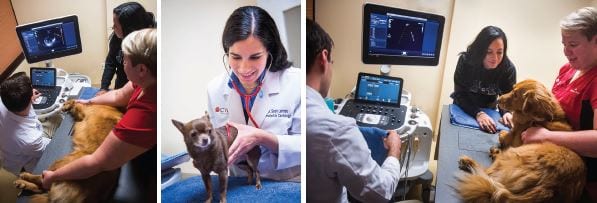What You Need to Know Concerning Vet Providers: An Introduction of Diagnostic Tools and Procedures
Vet services play a crucial role in maintaining the health and wellness of family pets. Routine examinations can reveal concealed health problems beforehand. Numerous analysis tools and treatments, such as blood examinations and imaging strategies, offer crucial understandings into a pet's well-being. Recognizing these approaches is key for family pet owners. What details diagnostic procedures are most frequently made use of, and just how can they impact a family pet's treatment plan?
Value of Normal Vet Exams
While lots of animal proprietors may take too lightly the value of regular veterinary check-ups, these visits are crucial for preserving an animal's overall health and wellness. Routine brows through to the vet permit very early discovery of prospective wellness problems prior to they escalate into significant issues. Normal check-ups typically consist of inoculations, which are very important for stopping contagious diseases that can drastically affect an animal's well-being. In addition, these visits supply a possibility for vets to examine the pet's weight, oral wellness, and general problem, ensuring that the family pet is prospering. During these gos to, animal proprietors can also receive useful advice on diet, workout, and precautionary treatment tailored to their specific pet dog's requirements.
Common Diagnostic Procedures in Vet Medication
In veterinary medication, precise medical diagnosis is essential for effective treatment. Common analysis treatments consist of blood screening strategies, progressed imaging modern technologies, and urinalysis, each playing a considerable function in recognizing health and wellness issues. Recognizing these approaches enhances the capacity to provide ideal treatment for animal patients.
Blood Examining Methods
Blood testing techniques work as important diagnostic tools in veterinary medication, enabling veterinarians to examine the health and wellness of pets accurately. These strategies include accumulating blood samples to analyze different parts, such as red and white blood cells, platelets, and biochemical pens. Usual tests consist of complete blood counts (CBC), which assess total health and discover infections, and biochemical panels, which evaluate body organ feature and metabolic status. Furthermore, serological tests can determine specific diseases with antibody detection. Blood testing is minimally invasive and provides essential info that assists in identifying problems, keeping an eye on health and wellness condition, and reviewing responses to therapies. On the whole, these strategies play a vital function in guaranteeing ideal take care of family pets and livestock alike.
Imaging Technologies Used
Diagnostic imaging modern technologies are crucial tools in veterinary medicine, complementing blood screening methods by supplying visual understandings into a pet's interior structures. Usual imaging techniques consist of X-rays, which work for examining bone fractures and finding international objects, and ultrasound, which permits real-time visualization of soft cells and body organs. Magnetic resonance imaging (MRI) uses comprehensive pictures of complex anatomical areas, especially in neurological assessments. Calculated tomography (CT) gives cross-sectional pictures, enhancing analysis precision for different conditions. Each of these innovations aids veterinarians in identifying health problems, intending therapies, and keeping an eye on recovery. By incorporating imaging technologies, vet professionals can better assess an animal's wellness and make educated choices concerning their care.
Urinalysis and Diagnostics
Urinalysis serves as a crucial diagnostic device in vet medication, providing useful insights right into an animal's overall health and wellness and assisting in the discovery of various conditions. This non-invasive procedure assesses urine examples to analyze kidney function, hydration condition, and metabolic problems. Usual components taken a look at consist of specific gravity, pH levels, sugar, proteins, and the visibility of blood or germs. Unusual searchings for can show concerns such as urinary system system infections, diabetic issues mellitus, or kidney condition. To boost diagnostic accuracy, urinalysis is commonly done combined with other examinations, such as blood job and imaging studies. Early discovery with urinalysis can bring about timely treatments, enhancing the diagnosis for several vet clients. Consequently, it is an essential element of comprehensive veterinary care.
Recognizing Blood Examinations and Lab Analysis
Comprehending blood examinations and laboratory analysis is vital in veterinary medicine as it assists in diagnosing various wellness conditions in animals. Different sorts of blood tests supply important information about an animal's internal state, while translating lab results needs cautious factor to consider of many factors. This section will discover the sorts of blood tests readily available and the value of their results.
Kinds Of Blood Tests
Blood tests play an important function in veterinary medicine, giving vital understandings into an animal's health standing. Various sorts of blood examinations are used, each offering various functions. Total blood matters (CBC) assess overall wellness and identify problems such as anemia or infection. Biochemical accounts examine organ feature by determining electrolytes and enzymes, offering understandings into metabolic wellness. Serological tests identify certain antibodies or pathogens, helping in the medical diagnosis of infections or autoimmune illness. Blood inputting warranties safe transfusions, while coagulation examinations determine the blood's capacity to clot, important for procedures. These tests jointly enhance diagnosis, therapy preparation, and surveillance of an animal's health, illustrating the significance of extensive laboratory analysis in veterinary treatment.

Interpreting Laboratory Results
A detailed analysis of laboratory outcomes is essential for accurate diagnosis and treatment in vet medication. Translating lab results requires an understanding of typical reference ranges and the value of variances. Blood examinations can disclose numerous wellness signs, such as body organ feature, electrolyte balance, and the existence of infections. Vets have to consider the entire clinical photo, consisting of the pet's history, physical examination findings, and any kind of signs offered. Variations in results might arise from elements such as age, breed, and underlying wellness problems. Laboratory outcomes must see post not be watched in seclusion however instead as part of a comprehensive analysis approach. Exact analysis enables for customized treatment plans and better outcomes for vet patients.
Imaging Techniques: X-rays, Ultrasounds, and Beyond
Imaging techniques are necessary devices in vet medicine, offering essential insights right into the health and health of animals. Among one of the most typically made use of approaches are Ultrasounds and x-rays. X-rays are very useful for envisioning bone structures, helping vets determine fractures, lumps, or international objects. This method is non-invasive and fast, making it suitable for urgent situations.Ultrasounds, on the various other hand, make use of sound waves to create photos of soft tissues and organs. This method is specifically valuable for taking a look at the heart, abdominal area, and reproductive organs, allowing veterinarians to evaluate problems like fluid accumulation or organ abnormalities.Beyond X-rays and ultrasounds, advanced imaging methods such as computed tomography (CT) and magnetic vibration imaging (MRI) are progressively used in veterinary method. These techniques offer in-depth cross-sectional photos, enhancing the accuracy of medical diagnoses and treatment plans. CT Scans For Dogs. On the whole, imaging methods play a crucial function in making sure reliable veterinary treatment
The Function of Biopsies in Diagnosing Animal Health And Wellness Issues
Precision in identifying health and wellness issues in pets typically hinges on using biopsies, which offer clear-cut information regarding tissue irregularities. A biopsy includes the removal of a small sample of cells for examination under a microscope, enabling vets to determine numerous conditions, including infections, growths, and inflammatory diseases. This analysis tool is important for comparing benign and deadly developments, leading treatment decisions, and reviewing the intensity of a condition.Biopsies can be carried out making use of different techniques, such as needle ambition, incisional biopsies, or excisional biopsies, depending on the area and kind of tissue entailed. The option of method might impact healing time and the amount of tissue collected. Ultimately, the details obtained from a biopsy can cause targeted therapies, improving end results for pets facing severe health challenges. Veterinarians highlight the relevance of this procedure in achieving accurate diagnoses and reliable treatment plans.
Advanced Diagnostic Tools: Endoscopy and CT Checks

Advanced analysis devices, such as endoscopy and CT scans, play a vital function in modern vet medicine, using non-invasive approaches to visualize inner structures and detect numerous conditions in pets. Endoscopy entails using a flexible tube furnished with an electronic camera, allowing vets to examine the intestinal system and breathing system directly. This method can expose abnormalities such as lumps, international bodies, or discover here inflammation, enabling targeted therapy plans.CT scans, on the various other hand, use advanced imaging innovation to produce comprehensive cross-sectional images of the body (Ultrasound For Dogs). This method is especially useful for evaluating complicated frameworks like the brain, spinal column, and joints. By supplying high-resolution pictures, CT scans assist veterinarians in identifying issues that might not appear via conventional radiography. Together, these innovative tools boost analysis accuracy, improve treatment outcomes, and inevitably add to much better total animal health and wellness management

Analyzing Examination Results: What Pet Dog Owners Must Know
Understanding test results can be a difficult job for pet dog owners, specifically after sophisticated procedures like endoscopy and CT scans have actually been performed. Interpreting these outcomes calls for an understanding of medical terminology and a clear understanding of what the findings indicate about the family pet's health. Vets usually give descriptions, yet the intricacy of the outcomes can still result in confusion.Pet proprietors should proactively take part in discussions with their veterinarians, asking inquiries to clarify any uncertainties. It is necessary to understand normal versus unusual outcomes and the effects for the pet's therapy plan. Furthermore, identifying that some outcomes may call for additional testing or tracking can help owners stay notified concerning their pet dog's wellness journey. Ultimately, a joint method in between click here for more info pet owners and veterinary specialists cultivates much better health end results and boosts the total treatment experience for pets.
Regularly Asked Concerns
Just how Do I Select the Right Veterinary Clinic for My Pet?
Picking the best vet facility includes investigating local choices, evaluating qualifications, seeing centers, and analyzing staff communications (Ultrasound For Dogs). Prioritizing suggestions from relied on sources can help ensure the best treatment and atmosphere for an animal's health and wellness demands
What Should I Do if My Pet Dog Rejects to head to the Vet?
When a family pet declines to go to the veterinarian, it's a good idea to continue to be calm, use deals with or toys to lure them, and think about arranging a home check out if anxiousness lingers. Perseverance and positive support are crucial.
Are There Telehealth Options for Vet Solutions?
Telehealth alternatives for vet solutions are progressively offered, permitting animal proprietors to talk to veterinarians from another location. These services enable conversations regarding health and wellness problems, recommendations on minor disorders, and follow-ups without needing to visit a facility.
Exactly how Usually Should My Pet Dog Have Oral Check-Ups?
The frequency of dental check-ups for pet dogs normally relies on their age and breed. Normally, veterinarians recommend yearly dental evaluations, although some animals may need more regular sees to maintain excellent dental health and wellness.

What Are the Costs Associated With Veterinary Diagnostics?
The prices related to veterinary diagnostics can vary extensively, generally ranging from standard tests like blood work to advanced imaging strategies. Aspects influencing expenses include the center's area, devices used, and certain tests required for every pet. Vet services play an important role in keeping the wellness of family pets. While numerous animal proprietors may underestimate the relevance of routine veterinary exams, these visits are essential for maintaining an animal's total health. Furthermore, these appointments give a chance for veterinarians to evaluate the pet's weight, dental health and wellness, and overall problem, making sure that the pet dog is flourishing. Accuracy in detecting health and wellness problems in family pets commonly pivots on the usage of biopsies, which give definitive information regarding tissue irregularities. Additionally, acknowledging that some results may call for further testing or monitoring can aid proprietors remain notified concerning their animal's health and wellness journey.